Sign up. Be inspired. Get clicking.
How does SAF reduce emissions? Exploring its benefits
1 January 2023
Sustainable Aviation Fuel (SAF) indeed holds promise for reducing aviation's environmental impact by offering up to an 80% reduction in carbon dioxide (CO₂) emissions across its lifecycle compared to traditional jet fuels. SAF is derived from renewable sources, such as used cooking oil, waste animal fats, and other biomass. This closed-loop process involves CO₂ absorption by feedstock materials like plants during their growth, which is later released upon combustion in an aircraft engine, aligning CO₂ levels in a more sustainable cycle rather than adding new emissions from fossil sources.
We at CarbonClick Supply Sustainable Aviation Fuel, to enquire of our service please click here
Furthermore, SAF contributes to air quality improvements by reducing particulate emissions by up to 90% and virtually eliminating sulfur emissions, benefiting communities around airports and along flight routes. Given that aviation currently contributes approximately 2-3% of global greenhouse gas emissions, SAF has the potential to play a significant role in the industry's journey towards more sustainable operations, though its widespread adoption still depends on overcoming production and cost challenges as technologies advance.
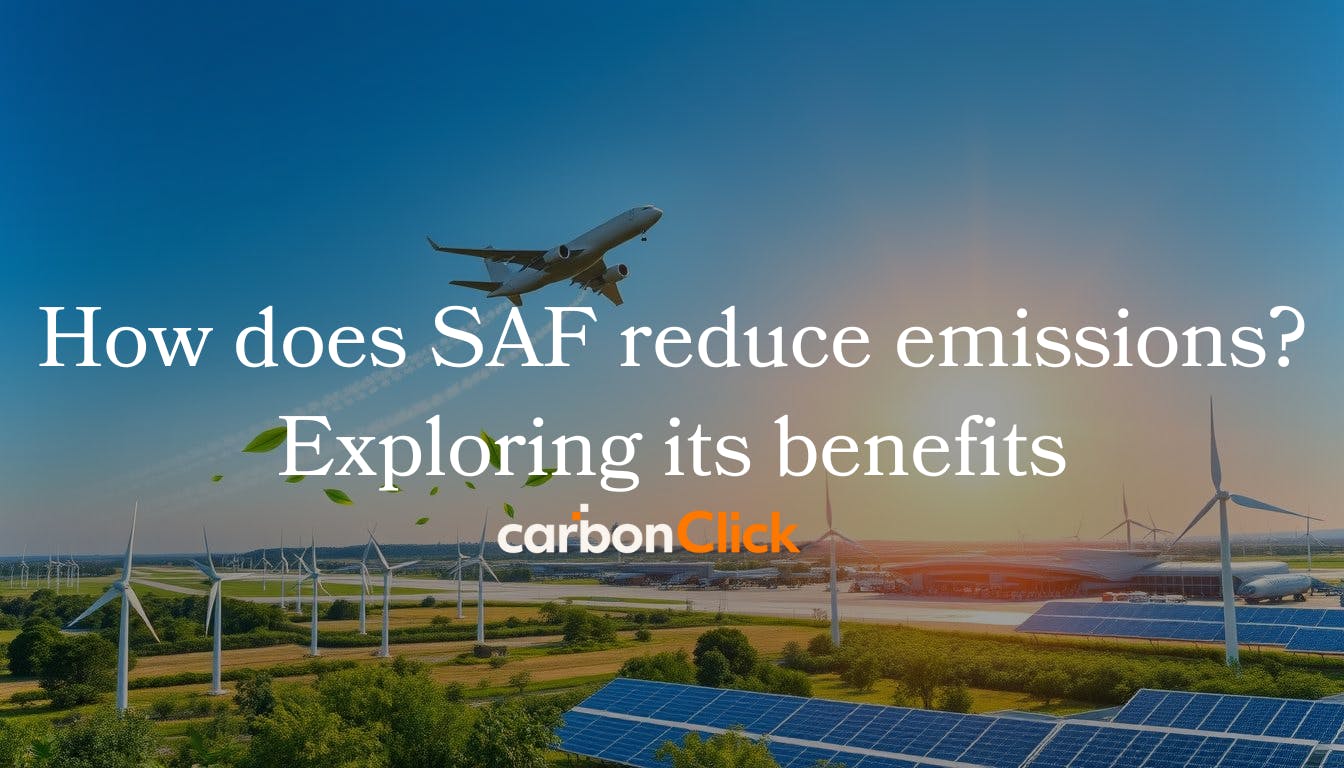
What is Sustainable Aviation Fuel (SAF)?
Sustainable aviation fuel: A renewable alternative for jet fuel
Sustainable Aviation Fuel (SAF) offers a viable renewable option to traditional jet fuel, sourced from feedstocks such as agricultural waste and used cooking oil. It is compatible with conventional jet fuel, requiring no modifications to existing aircraft or airport infrastructure.
Understanding the renewable alternative to fossil jet fuel
SAF is integral to aviation’s efforts to significantly reduce carbon emissions and lessen the industry’s environmental footprint. By 2022, more than 450,000 flights worldwide had already used SAF, spanning 46 airports, mainly within the United States and Europe.
Sustainable aviation fuel in action
An airplane glides through clear skies, trailing a symbolic stream of biofuel droplets and leaves. Below, a modern landscape of wind turbines and solar panels underlines the shift towards renewable energy, with the sun illuminating an airport where technology and sustainability intersect.
In the United States, the Environmental Protection Agency (EPA) reported a notable increase in SAF usage, from roughly 5 million gallons in 2021 to 15.84 million gallons in 2022. Expectations for 2023 are set at 24.5 million gallons, reflecting aviation’s commitment to reducing its emissions.
How is SAF produced?
There are several SAF production methods. Hydrotreated Esters and Fatty Acids (HEFA) processes convert vegetable oils, waste oils, or fats into SAF, while the Alcohol to Jet (AtJ) pathway transforms alcohols, such as ethanol, into sustainable fuel. eFuels, or Power-to-Liquid (PtL) fuels, rely on hydrogen and renewable electricity to produce synthetic alternatives. Each pathway adapts sustainable feedstocks into usable fuel, underscoring the diversity and flexibility of SAF production technologies.
Exploring SAF pathways: HEFA, Alcohol to Jet, and eFuels
The HEFA process is widely adopted, with numerous commercial plants operational globally. Alcohol to Jet is promising in its conversion of alcohols to jet fuel, while eFuels leverage renewable electricity and hydrogen to produce synthetic SAF. These diverse production methods support the scalability of renewable jet fuel and demonstrate SAF’s potential to meet aviation fuel demand.

Lifecycle emissions reduction with SAF
Sustainable Aviation Fuel (SAF) represents a transformative option for air travel, capable of reducing lifecycle carbon emissions by up to 80% compared to conventional jet fuel. This significant reduction is achieved through SAF’s closed-loop carbon process. Although SAF still produces emissions when burned, the CO₂ released during flight is subsequently reabsorbed by the biomass that forms its feedstock, thereby minimising the aviation sector’s dependency on fossil fuels and lessening its carbon footprint.
SAF lifecycle emissions reduction
To illustrate SAF’s lifecycle, envision a modern aircraft flying under a clear sky, with SAF production stages visualised as clean energy sources—wind turbines and solar panels—integrated harmoniously with technology and nature.
The International Civil Aviation Organization (ICAO) uses a precise method for calculating lifecycle emissions of SAF, expressed in grams of CO₂ equivalent per megajoule (gCO₂e/MJ). This approach is crucial for assessing SAF’s environmental contributions and for meeting key sustainability objectives set by the aviation industry.
How does SAF reduce emissions?
Closing the carbon cycle: Absorbing and releasing CO2
Sustainable Aviation Fuel (SAF) offers significant emissions reductions by utilising carbon from ongoing cycles. Unlike traditional jet fuel, SAF doesn’t introduce new carbon into the atmosphere. Instead, the CO₂ produced during flight is offset as it’s absorbed by the biomass used in SAF’s production, effectively creating a closed carbon cycle. This approach substantially reduces aviation’s carbon footprint and reliance on fossil fuels, promoting a more sustainable future for air travel.
SAF can reduce lifecycle carbon emissions by up to 80% compared to conventional fuels. It can also be blended with up to 50% standard jet fuel without altering aircraft or infrastructure, making it a viable, sustainable choice for the aviation industry.
Currently, SAF makes up only about 0.2% of global jet fuel consumption. However, the sector is focused on expanding SAF by increasing feedstock variety and enhancing production and distribution. With continued investment and support, the aviation industry aims to achieve net-zero emissions by 2050, with SAF being instrumental in meeting this target.
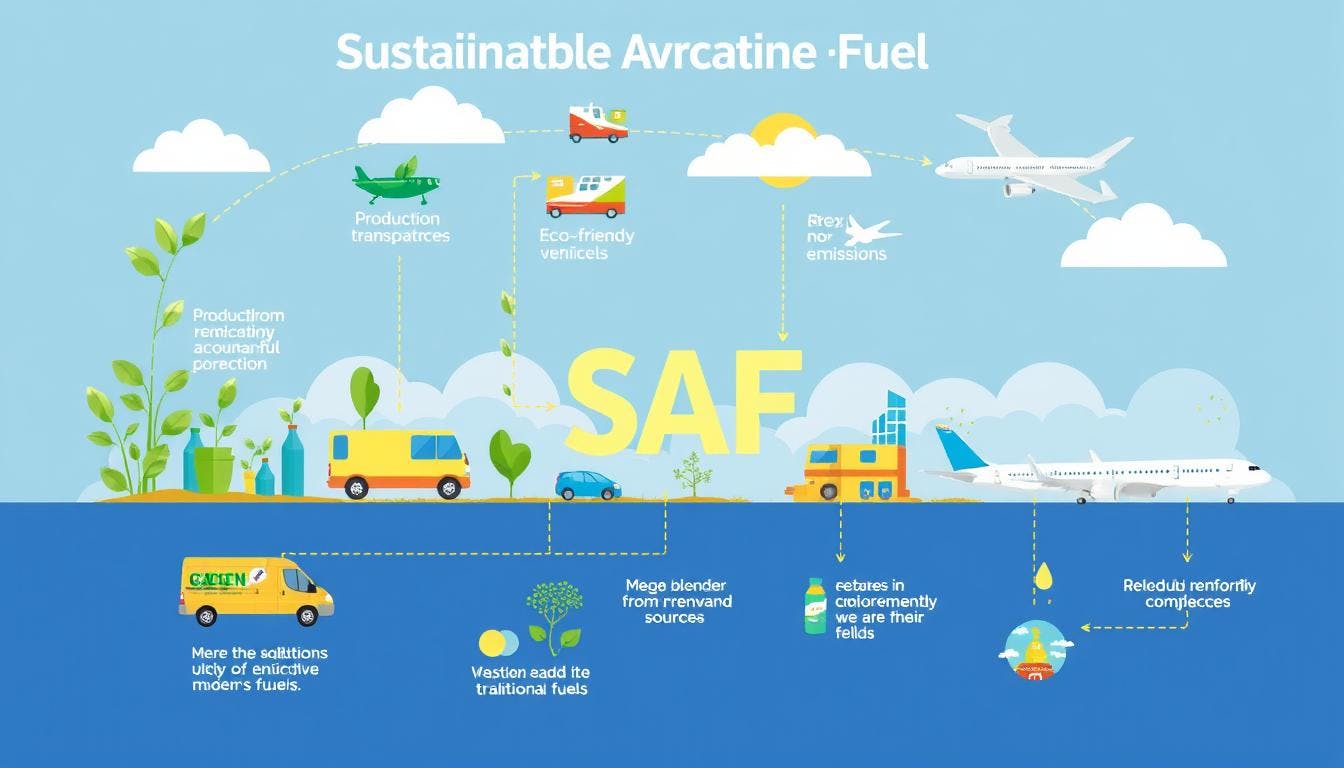
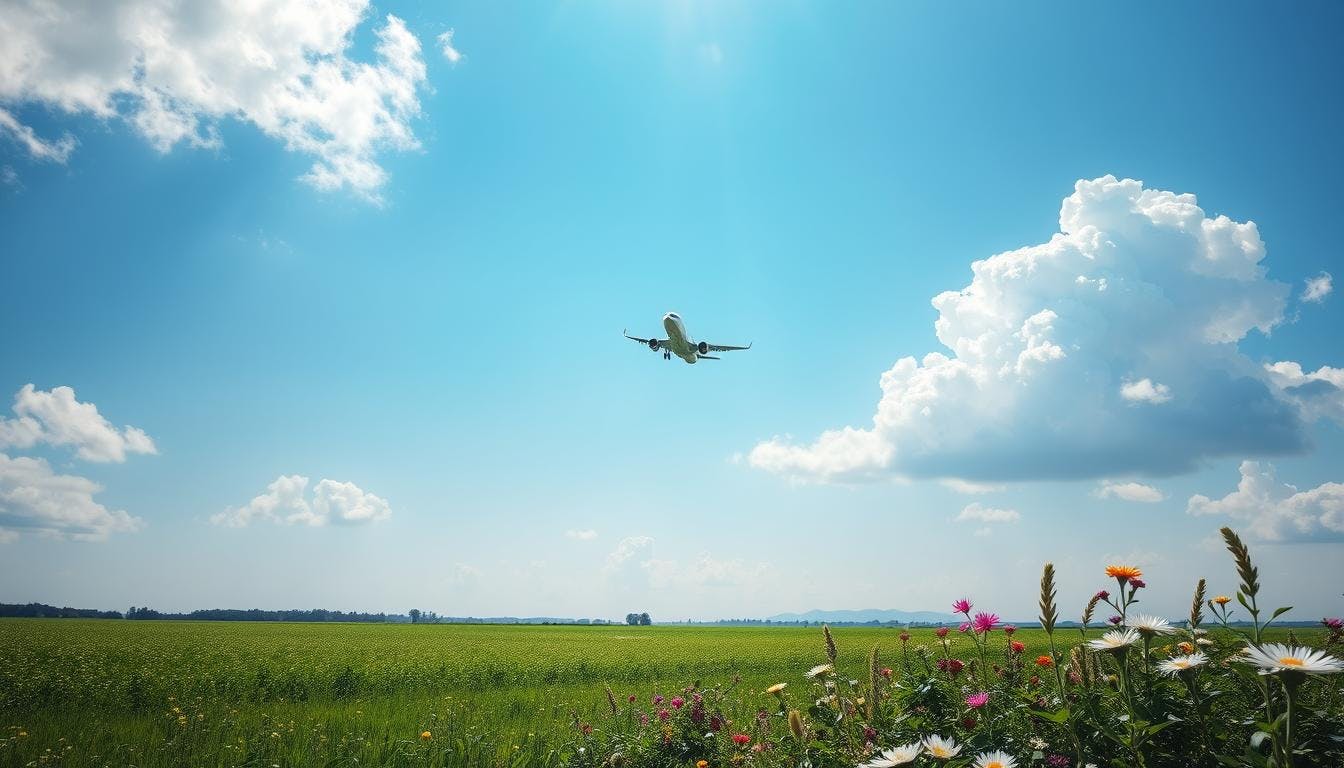
Benefits of SAF over conventional Jet fuel
Sustainable Aviation Fuel (SAF) offers significant advantages over conventional jet fuel, especially by substantially lowering carbon emissions and improving air quality. SAF reduces particulate emissions by as much as 90% and nearly eliminates sulphur emissions, leading to cleaner air—benefiting both the environment and aviation.
In addition to sulphur reduction, SAF lessens the impact of harmful particulate emissions, which pose risks to both public health and ecosystems. SAF can cut lifecycle emissions by up to 80% compared to standard fuels, and it can blend seamlessly with up to 50% traditional jet fuel without necessitating changes to current aircraft or infrastructure, making it a practical, sustainable option for the aviation industry.
Despite representing just 0.2% of global jet fuel use today, SAF production and investment are expanding, focusing on diverse feedstocks, increased efficiency, and wider distribution. These efforts aim to make SAF integral to achieving the aviation industry's goal of net-zero emissions by 2050, positioning it as a cornerstone of sustainable flight.
Sustainable feedstocks for SAF production
Sustainable Aviation Fuel (SAF) is a key to cutting emissions in flying. It's an environmentally-friendly alternative to regular jet fuel. It comes from things like old cooking oil, agricultural waste, and hydrogen produced from renewable sources.
Using these materials makes SAF production better for the planet. It avoids the harm caused by cutting down forests for fuel.
SAF is special because it can help close the carbon cycle. Materials like farm waste and old trash absorb CO2. This CO2 is released when making SAF, but it's a better choice than regular jet fuel.
Companies like SkyNRG focus on using waste and non-food items for SAF. This helps save food and tackles waste problems. It turns trash into fuel.
The aviation world is looking for ways to be more sustainable. Having many sustainable feedstocks for SAF is key. It helps make this sustainable fuel more common. Together, we can make flying more sustainable.
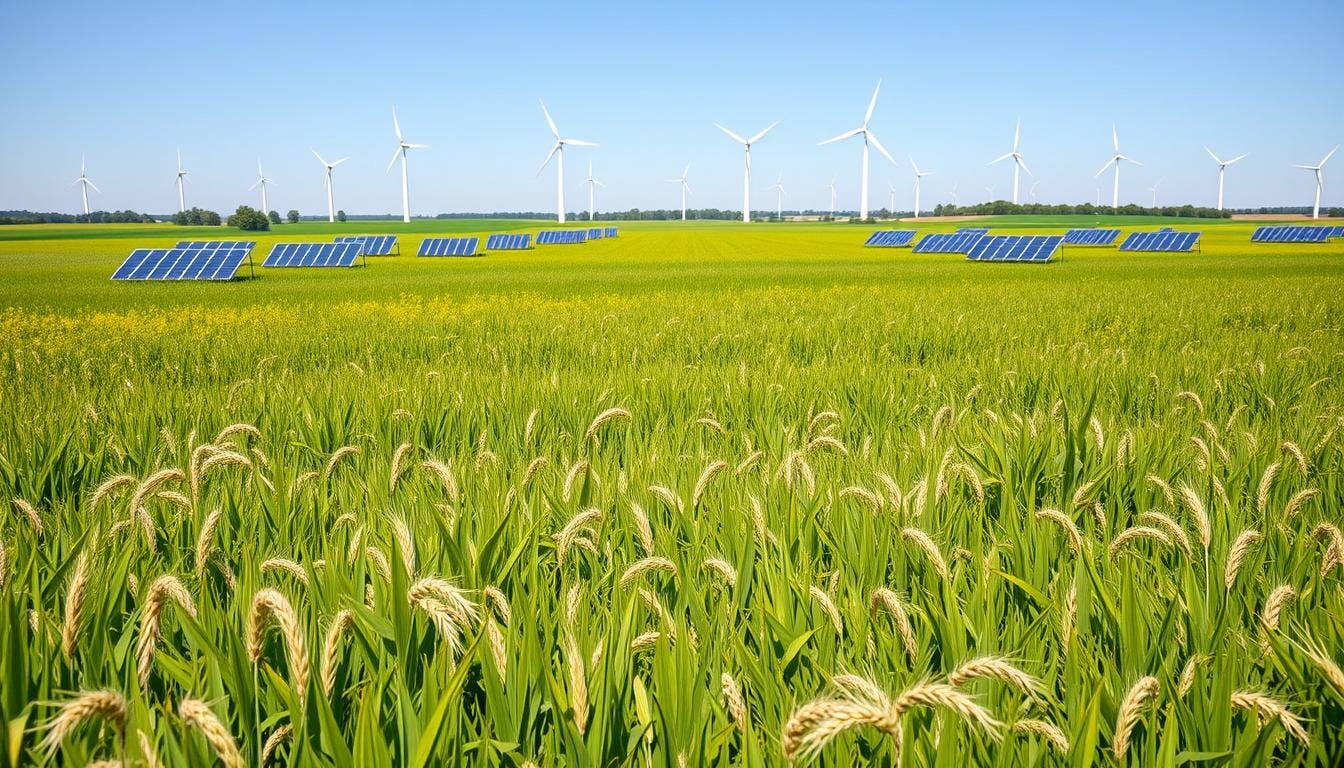
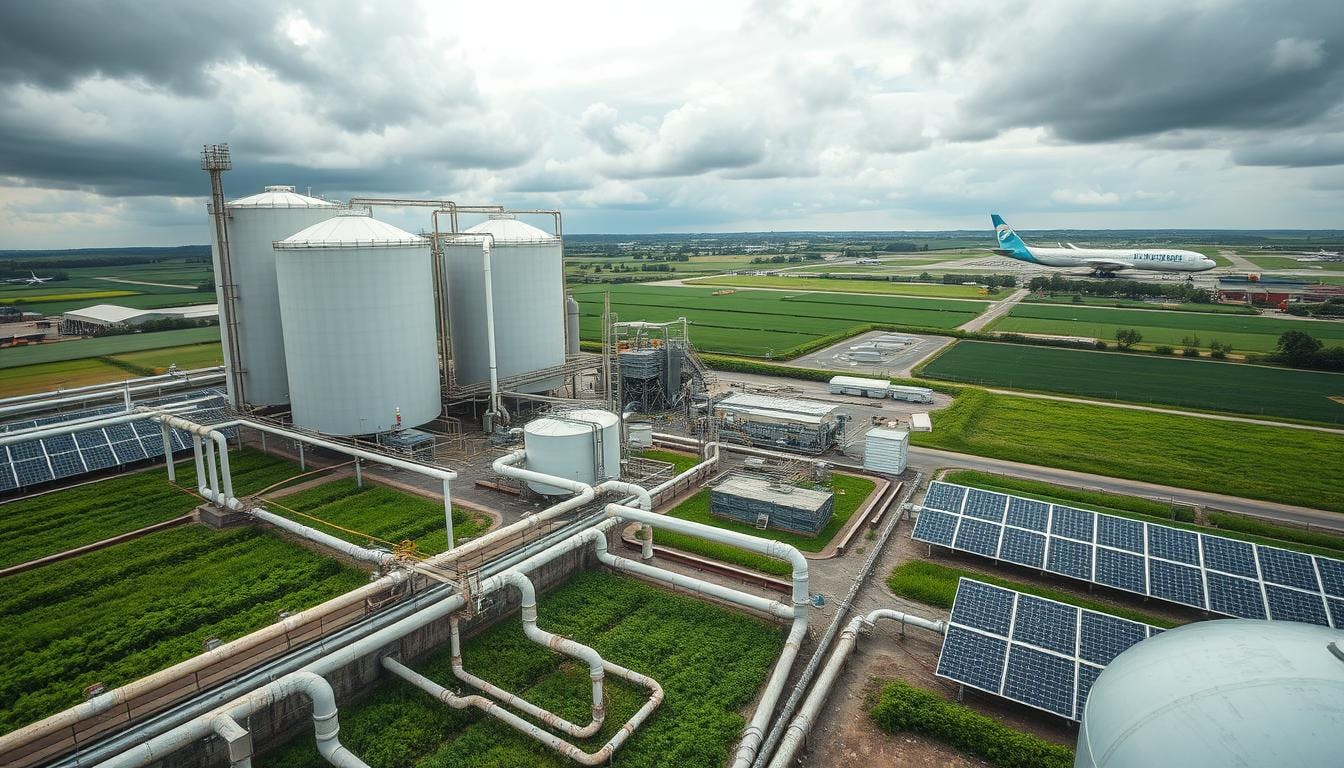
Current challenges in SAF adoption
SAF has numerous advantages, but its uptake faces several hurdles. The primary concern is the limited production capacity of SAF, which currently constitutes only around 0.1% of jet fuel used globally. This scarcity hampers efforts to satisfy the growing demand for this sustainable alternative.
Limited production capacity and higher costs
Another significant challenge is the elevated cost of SAF, which is two to five times more expensive than conventional jet fuel. This price disparity discourages airlines and consumers from opting for SAF. Addressing these obstacles, such as limited SAF production capacity and the higher costs associated with SAF, is vital for dismantling barriers to its adoption and ensuring this sustainable option becomes more accessible in aviation.
As the demand for air travel increases, the urgency for more SAF production intensifies. It must be manufactured on a larger scale and at a reduced cost. Industry stakeholders are working to confront these challenges in SAF adoption, aiming to fully harness this technology to lower emissions and encourage a more sustainable future for aviation.
Scaling up SAF production and availability
The aviation sector is rapidly progressing towards greater sustainability, necessitating an increased supply of Sustainable Aviation Fuel (SAF). Companies like SkyNRG are establishing SAF plants in Europe and the U.S., which is crucial for satisfying the demand for this alternative jet fuel.
The SAF landscape is evolving, and we anticipate more innovative production methods and materials to enhance SAF manufacturing capacity and meet the rising demand. This expansion will assist the aviation industry in achieving its sustainability objectives.
Scaling up SAF production
SAF production has significantly increased, with over 600 million litres produced in 2023, a rise from the previous year. The U.S. experienced substantial growth in SAF production and imports, increasing from 5 million gallons in 2022 to 52 million gallons in the first half of 2024.
This 52 million gallons of SAF can reduce CO2 emissions by over 300,000 metric tons. However, there remains a considerable distance to travel. Global SAF production could expand 15 times in 2024, yet it would still represent only about 1% of the industry's total needs.
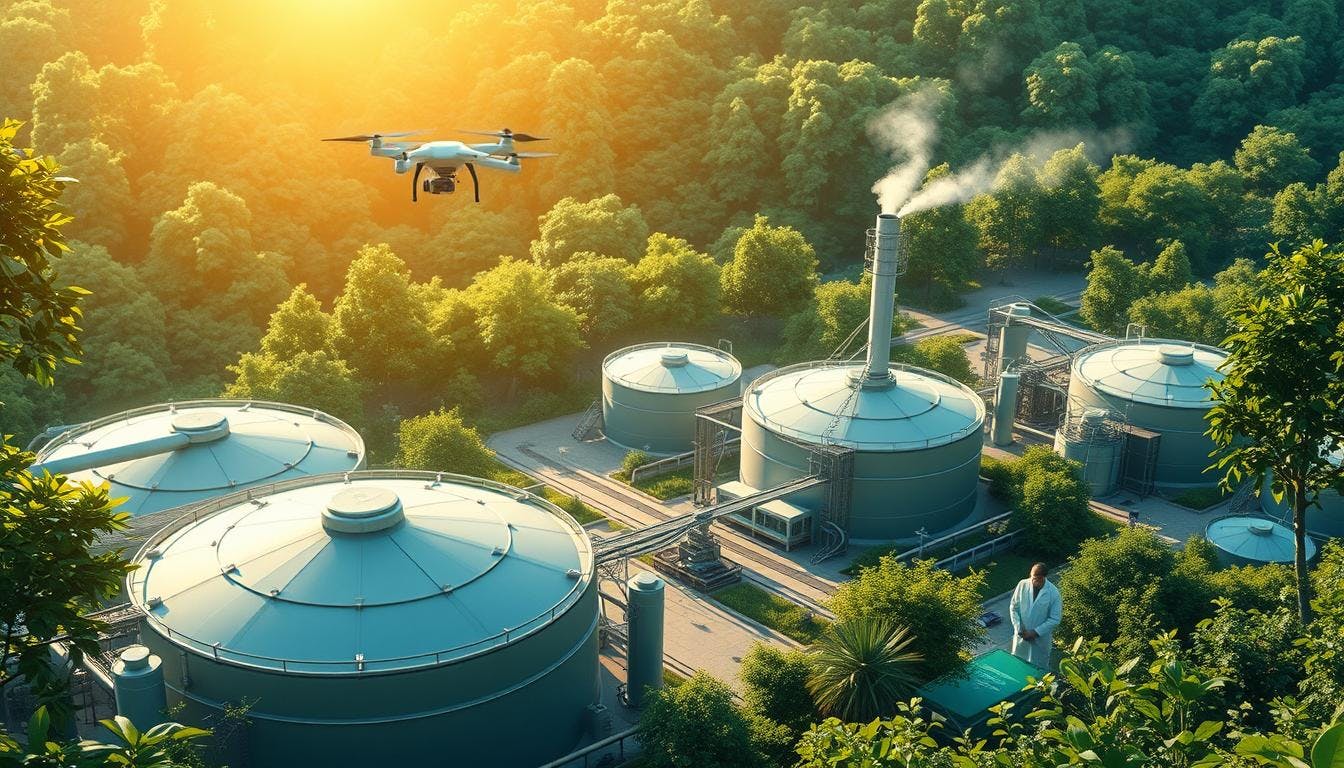
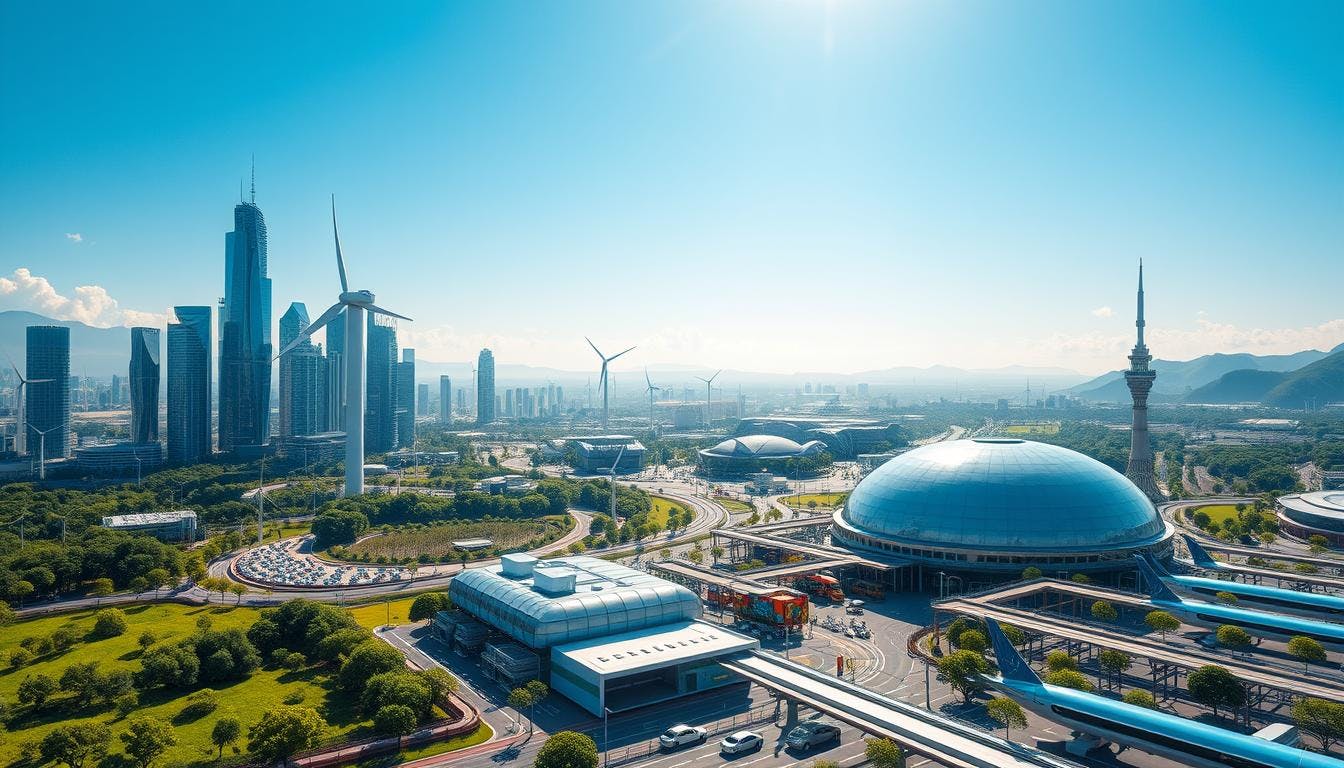
Regulatory support and policy frameworks for SAF
Creating the right rules and policies is essential for Sustainable Aviation Fuel (SAF) to become commonplace. Global collaboration is necessary to make SAF affordable, which involves establishing new systems, reaching consensus on what defines sustainable SAF, and promoting supportive policies at all levels.
The ReFuelEU Aviation rules in the European Union exemplify efforts to increase SAF usage. Governments, businesses, and regulators are collaborating to provide regulatory support, policy frameworks, and government initiatives for SAF, fostering international cooperation in this area.
SAF policy and regulation
The EU's ReFuelEU Aviation plan mandates that fuel suppliers, airlines, and airports increase their SAF usage, starting in 2025. Additionally, the EU plans to raise taxes on aviation fuels over a decade, making them more costly compared to other fuels.
In the United States, the Biden Administration aims to enhance SAF production, targeting 3 billion gallons by 2030 and 35 billion gallons by 2050. The Department of Energy and the Federal Aviation Administration are investing in SAF projects to accelerate progress in the industry.
Industry initiatives and collaborations for SAF deployment
The aviation industry is making significant efforts through industry initiatives and collaborations to advance Sustainable Aviation Fuel (SAF). Companies like SkyNRG are partnering with airlines, airports, and other stakeholders to foster cooperation and support. Their objective is to make SAF more affordable, assist producers in obtaining certification, and share valuable insights.
These initiatives are accelerating the adoption of SAF within the industry. The goal is to produce 3 billion gallons of SAF in the US by 2030 and 35 billion gallons by 2050, which will reduce aviation's CO2 emissions by at least 50%.
Industry initiatives for SAF
Through these industry-wide collaborations, the aviation sector is building a robust SAF system. These partnerships are vital in addressing production and cost challenges, playing a crucial role in achieving a sustainable future for air travel.
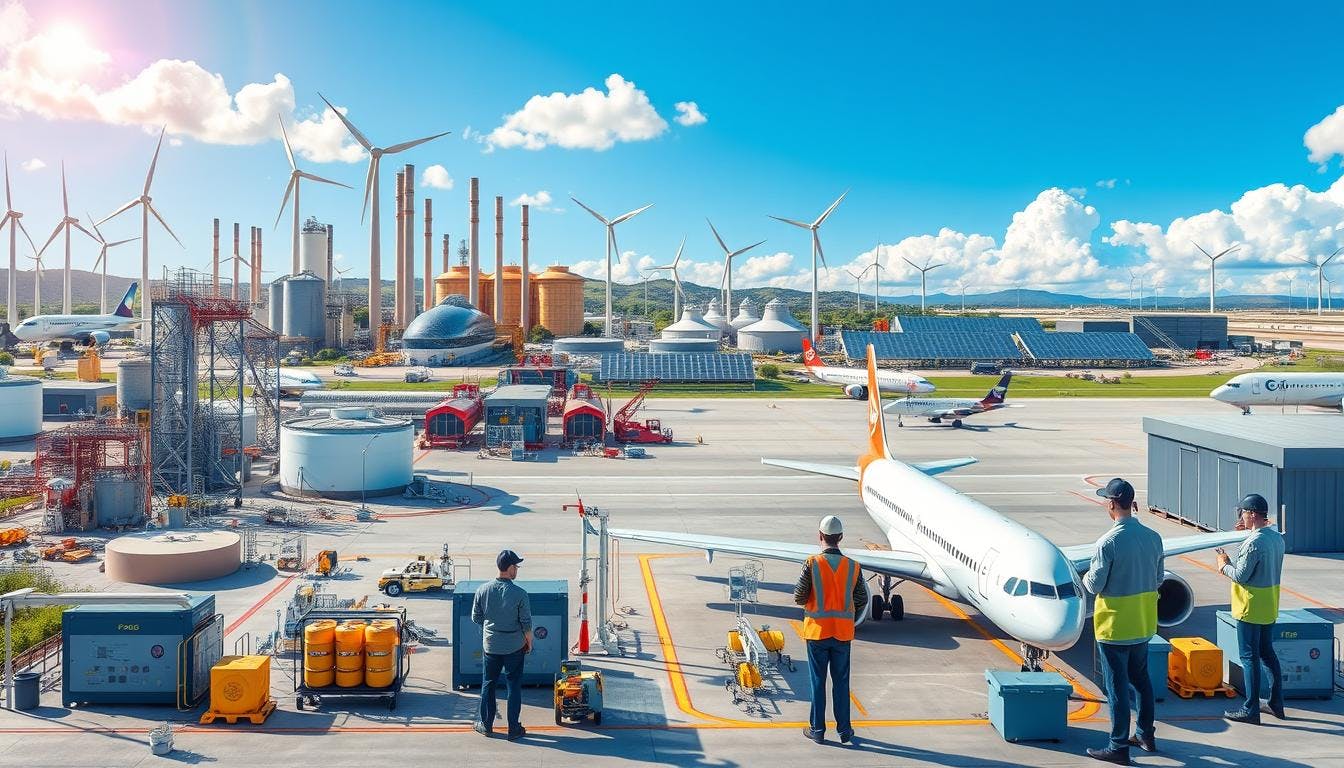
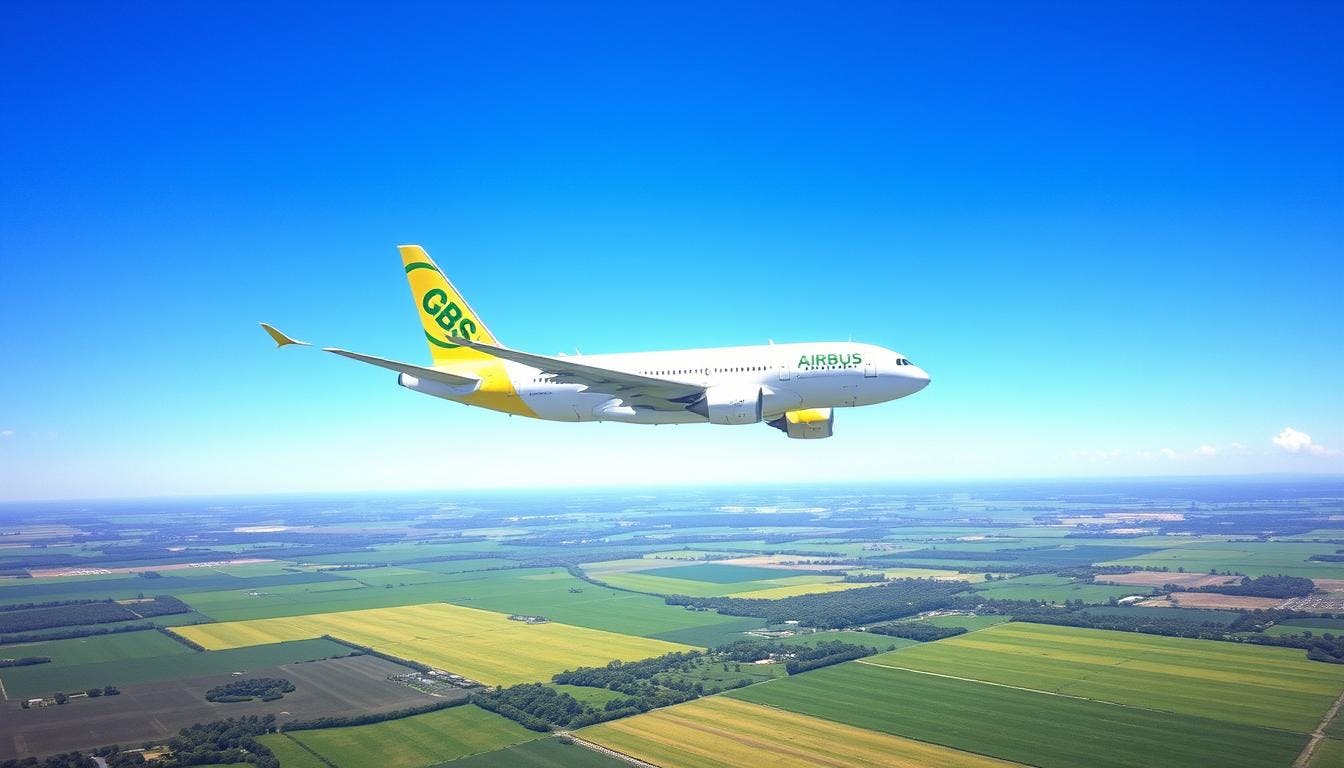
Airbus' role in promoting SAF usage
Airbus is a top aircraft maker, leading the way in using Sustainable Aviation Fuel (SAF). The company is working hard to incorporate SAF into its operations, aiming to have at least 15% SAF in its fuel mix by 2024. By 2030, Airbus wants to use even more SAF, targeting 30% of its fuel to be sustainable. This demonstrates Airbus's commitment to reducing emissions.
Airbus is not just utilising SAF itself; it's also helping the wider SAF community. Since 2016, it has allowed customers to use SAF in their new planes, aiding them in lowering emissions. The company is also testing planes powered by 100% SAF to evaluate the fuel's environmental effects.
Airbus is collaborating with airlines, airports, and others to promote SAF use, working on policies and helping to meet demand. This initiative is part of Airbus's plan for a more sustainable future in aviation.
The future of Sustainable Aviation: SAF's potential impact
Sustainable Aviation Fuel (SAF) is set to be crucial in making air travel more sustainable. It cuts lifecycle carbon emissions by up to 70% compared to regular jet fuel. This makes SAF essential for the aviation industry's goal to reduce carbon emissions and move towards a cleaner future.
As SAF production increases and costs decrease, it will become more widely used. This is vital for the aviation sector to enhance its sustainability. It will aid in lowering carbon emissions and making air travel more responsible.
SAF is anticipated to significantly lessen air travel's environmental impact. The global market for sustainable aviation fuel is projected to reach around US$14,842.13 million by 2032, reflecting the industry's commitment to sustainable fuel options.
Groups like the Clean Skies for Tomorrow Coalition aim for 10% SAF usage by 2030. Governments are also establishing targets for increased SAF consumption. These initiatives are shaping the future of sustainable aviation.
The aviation sector aims to be net zero by 2050, and SAF is integral to this objective. IATA believes SAF could help reduce emissions by about 65% to achieve this target. By utilising SAF, the industry can lessen its carbon footprint and progress towards a more sustainable future.
17 South Street
Auckland 1010
New Zealand
info@carbonclick.com- -
- X
Subscribe now to stay up to date with CarbonClick, carbon offsetting and climate action.
By signing up you agree to our Privacy Policy.


